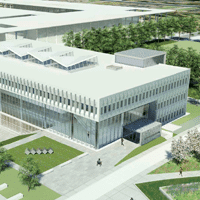The University at Albany, part of the State University of New York (SUNY) system, had several advantages as it transitioned toward further sustainability throughout the past decade. One is that the campus was largely constructed in the 1960s, allowing some economies from replication between structures. Another is that publicly owned, institutional buildings freed up planners to make energy upgrades that pay for themselves over building lifecycles—not just three or five years. And in a backhanded way, a state legislature-forced 30-percent reduction of the SUNY-wide operating budget made energy reduction an imperative rather than a choice.
A university with 18,000 students, however, has a lot of human power to leverage as well, which the UAlbany Office of Environmental Sustainability does to a meaningful degree. Located in the Northeast, UAlbany is like many colleges and universities in that it must deal with the “shoulder season,” those times in the spring and fall when warm temperatures can make classrooms uncomfortable. But university engineer and LEED AP Indu (who uses no surname) explains, “All of our new construction and renovation projects include operable windows to help the occupant deal with this situation.” On a warm day in March, for instance, students can use windows instead of air-conditioning.
To promote these options, UAlbany has a website (UAlbany Green Scene, albany.edu/gogreen) with social media extensions and news of hands-on programs that encourage students to conserve and recycle. Twitter and Facebook are utilized to advertise ways for students to get involved. “The Green Scene initiative has led to behavioral changes that yield more than five percent energy savings,” Indu says. According to Mary Ellen Mallia, the university’s director for environmental sustainability, the university currently achieves a 38 percent recyclable trash diversion rate, up from a 9 percent diversion rate in 2005.
Events, blogs, and academic programs built around campus sustainability informs the university population on some of the more visible components of the program, such as a LEED Gold-certified, 500-unit dormitory, its 96,000-square-foot School of Business building (targeting LEED Gold certification), and the university’s data center, which, planned with the help of Virginia-based engineering firm SAIC, will recover heat from the center’s servers to warm adjoining offices. Water conservation is evident in a rainfall-retention pond, used for irrigation, a rain garden at the Alumni House, and responsibly managed fountains that have long served as icons of the institution.
Those are the aspects of UAlbany’s sustainability initiatives that are in plain sight. What are not seen are the improvements to the school’s mechanical systems that save the school $500,000 per year and reduce carbon emissions by 14 percent. Or the LEED-certified dormitory that is the first on campus to resource all heating and cooling from a geothermal system, made possible in part by a $2.7 million US Department of Energy grant. Indu and her team employ meters, sub-meters, and control points to monitor its efficacy and eventually build a case for geothermal systems on future projects.
Campus-wide, the school’s 1960s buildings are getting double-pane, low-E windows and new roof membranes, insulation, and lighting with energy-saving alternatives. Most students, though, will see none of this—except, perhaps, on Facebook and Twitter.


